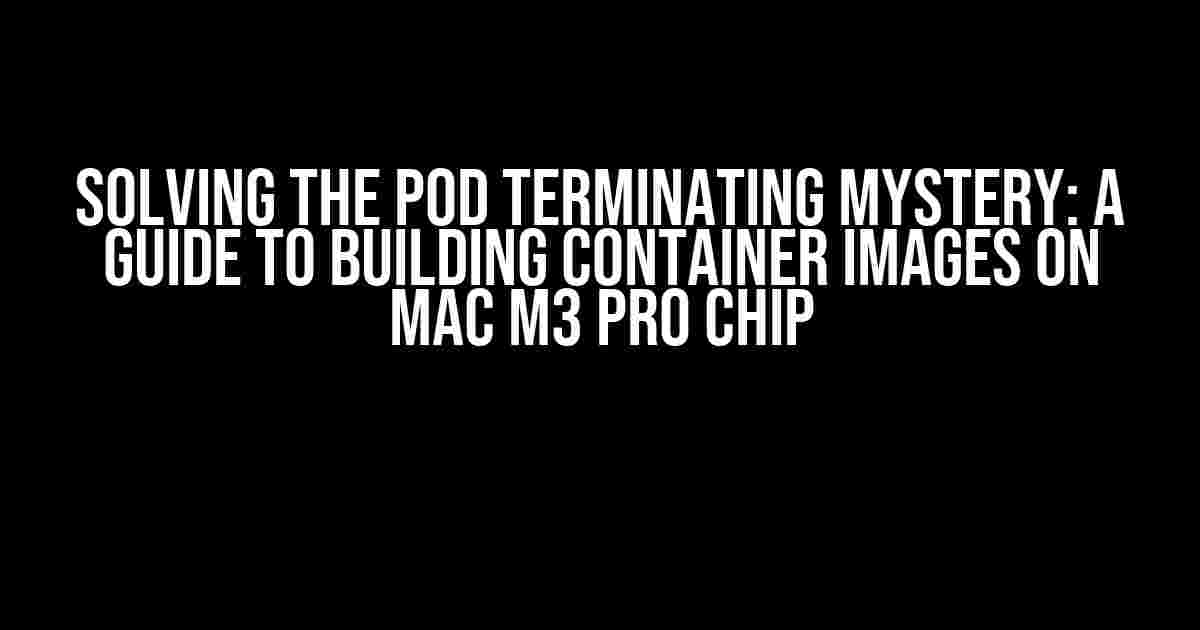Are you tired of seeing your pods terminate unexpectedly when building container images on your Mac M3 Pro chip? You’re not alone! Many developers have fallen victim to this frustrating issue, but fear not, dear reader, for we’re about to dive into the root cause and provide a step-by-step solution to this problem.
What’s causing the pod terminating issue?
Before we dive into the solution, let’s understand what’s causing this issue in the first place. When building container images on a Mac M3 Pro chip, the container runtime environment can become incompatible with the ARM-based chip, leading to pod termination. This incompatibility arises from the fact that most container images are built with x86 architecture in mind, not ARM.
The Role of QEMU and Docker
To understand the issue better, let’s explore the role of QEMU and Docker in containerization.
Docker uses a technique called binfmt_misc to execute foreign binaries. This allows Docker to run containers with different architectures, including ARM, on a x86 host. However, this approach has limitations, and when building container images on a Mac M3 Pro chip, the QEMU emulation layer can become a bottleneck, leading to pod termination.
The QEMU emulator translates ARM instructions to x86, which can result in: - Performance overhead - Increased memory usage - Incompatibility issues
Solving the Pod Terminating Issue: A Step-by-Step Guide
Now that we understand the root cause, let’s walk through a step-by-step guide to building container images on a Mac M3 Pro chip without pod termination.
Prerequisites
- Docker installed on your Mac M3 Pro chip
- Familiarity with Docker and containerization concepts
Step 1: Install the Docker Apple Silicon Preview
First, you need to install the Docker Apple Silicon Preview, which provides native support for ARM-based chips like the M3 Pro.
$ brew install --cask docker-apple-silicon-preview
Step 2: Set Up the Docker Environment
Next, set up the Docker environment to use the Apple Silicon Preview.
$ docker context use apple-silicon-preview
Step 3: Build Your Container Image
Now, build your container image using the following command:
$ docker build -t my-image:latest .
Step 4: Run the Container
Finally, run the container using the following command:
$ docker run -p 8080:8080 my-image:latest
Additional Tips and Considerations
QEMU Emulation Layer
When building container images, it’s essential to be mindful of the QEMU emulation layer. To avoid performance overhead and incompatibility issues, consider the following:
- Optimize your Dockerfile for ARM architecture.
- Avoid using
binfmt_miscwhenever possible. - Use the
--platformflag to specify the target platform.
$ docker build --platform=linux/arm64 -t my-image:latest .
Docker Compose and Multi-Arch Images
If you’re using Docker Compose, ensure you’re using the latest version, which supports multi-arch images.
$ docker-compose --version
When building multi-arch images, use the following format:
$ docker buildx build --platform=linux/arm64,linux/amd64 -t my-image:latest .
Conclusion
In conclusion, building container images on a Mac M3 Pro chip can be a breeze if you follow the right steps. By installing the Docker Apple Silicon Preview, setting up the Docker environment, and building your container image with the correct architecture in mind, you can avoid pod terminating issues and ensure a smooth development experience.
Remember to stay mindful of the QEMU emulation layer and optimize your Dockerfile for ARM architecture. With these tips and considerations in mind, you’ll be well on your way to building robust and compatible container images on your Mac M3 Pro chip.
| Troubleshooting Tips | |
|---|---|
| Pod terminating issue persists | Check Docker logs for errors, and ensure the Docker Apple Silicon Preview is installed and configured correctly. |
| QEMU emulation layer performance issues | Optimize your Dockerfile for ARM architecture, and consider using the --platform flag to specify the target platform. |
| Multi-arch image building issues | Ensure you’re using the latest version of Docker Compose, and follow the correct format for building multi-arch images. |
With this comprehensive guide, you’re now equipped to tackle the pod terminating issue and build container images on your Mac M3 Pro chip with confidence. Happy building!
Frequently Asked Question
Having trouble with pods terminating when building container images on a Mac M3 Pro chip? You’re not alone! We’ve got the answers to your burning questions.
Why do pods terminate when building container images on a Mac M3 Pro chip?
This Pod-terminating issue is often due to the differences in the architecture of the M3 Pro chip compared to traditional x86_64 processors. The build process may result in an incompatible image that causes the Pod to crash or terminate.
Is this issue specific to the Mac M3 Pro chip or can it occur on other Apple Silicon devices?
While the M3 Pro chip is more prone to this issue, it’s not exclusive to this device. Any Apple Silicon-based Mac, such as the M1 or M2, can potentially experience Pod terminating issues when building container images.
Can I avoid this issue by using a different container runtime?
Yes, you can! Using a container runtime like Docker that supports multi-arch images can help mitigate this issue. Additionally, you can explore other container runtimes like Podman or Containerd, which might provide better compatibility with Apple Silicon devices.
Are there any workarounds to build container images on a Mac M3 Pro chip without Pod termination?
A popular workaround is to use a buildx command with the –platform flag to specify the target architecture (e.g., linux/amd64). This allows you to build an image that’s compatible with the x86_64 architecture,even on an Apple Silicon device.
Will this issue be resolved in future updates to Docker or Kubernetes?
The Docker and Kubernetes communities are actively working on improving support for Apple Silicon devices. While there’s no ETA for a specific fix, you can expect future updates to address these compatibility issues and provide a smoother experience for developers.

